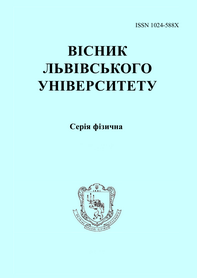Visnyk of the Lviv University. Series Physics
55 (2018) ñ. 62-70
DOI: https://doi.org/10.30970/vph.55.2018.62
Plasmonic spectra of silver nanoparticles
I. Bolesta, A. Vaskiv, S. Velgosh, O. Kushnir, Ya. Shmygelskyy
|  |
The article deals with silver colloid, obtained by one of the methods of "bottom-up" type. Namely, the method of restoring silver from an alcoholic solution \mathrm{AgNO3} under the action of ultraviolet radiation. In the absorption spectra of the resulting colloids three bands at 301, 330 and 420 nm were detected. Two short-wave bands are probably related to the formation of small clusters of silver, which are formed from atoms and/or metal ions in the radiation-chemical restoration of ions \mathrm{Ag+} under the action of UV-radiation. The article analyzes the possible mechanisms for the formation of such small clusters. The authors consider the longwave band at 420 nm as associated with plasmon resonance in silver nanoparticles of larger sizes. To estimate the distribution by size of these nanoparticles, the authors used their own technique for processing optical absorption spectra. For this, a set of spectra for particles of different sizes is calculated in the Mi theory. By changing the contribution of each of the spectra, the deviation of the superposition of the calculated spectra and the experimental absorption spectrum is minimized. The resulting adjustment coefficients correspond to the particle size distribution. Thus it was found that nanoparticles with radii of 22 nm to 30 nm have the greatest contribution. It is shown that the result obtained is commensurate with the other estimates of the size of silver nanoparticles in the experimental colloid.
Full text (pdf)
References
- V. V. Klimov, Nanoplasmonics, (Fizmatlit, Moscow, 2010), 480 p.
- S. A. Maier, Plasmonics: theory and applications, (SPC «Regular and Chaotic Dynamics», Moscow-Izhevsk, 2011), 296 p.
- M. Stockman, Opt. Exp. 19, 22029 (2011). doi:10.1364/OE.19.022029.
- I. P. Suzdalev, Nanotechnology: physical chemistry of nanoclusters, nanostructures and nanomaterials, (KomKniga, Moscow, 2006), 592 p.
- S. Lal, S. E. Clare and N. J. Halas, Accounts Chem. Res. 41, 184 (2008). doi:10.1021/ar800150g.
- H. Atwater and A. Polman, Nat. Mater. 9, 205 (2010). doi:10.1038/nmat2866.
- M. Hu, J. Chen, Z. Li, L. Au, G. Hartland, X. Li, M. Marquez and Y. Xia, Chem. Soc. Rev. 35, 1084 (2006). doi:10.1039/B517615H.
- M. A. Garcia, Surface plasmons in biomedicine Recent Developments in Bio-Nanocomposites for Biomedical Applications, (Novascience Publishers, New-York, 2010), 372 p.
- M. Garcia, J. Phys. D: Appl. Phys. 44, 283001 (2011). doi:10.1088/0022-3727/44/28/283001.
- B. Ershov, Bulletin of the Russian Academy of Sciences. Division of Chemical Sciences. 1, 1 (1999).
- B. Ershov, Rossiiskii khimicheskii zhurnal. Russian chemical journal. 45 (3), 20 (2001).
- U. Kreibig, M. Gartz, A. Hilger and R. Neuendorf, Nanostr. Mat. 11 (8), 1335 (1999). doi:10.1016/S0965-9773(00)00426-8.
- B. Ershov, E. Janata and A. Henglein, J. Phys. Chem. 97, 339 (1993). doi:10.1021/j100104a013.
- I. Bolesta, Fizychnyi zbirnyk NTSH. Physical Collection SSSh. 7, 9 (2008).
- T. Witten and L. Sander, Phys. Rev. Lett. 47 (19), 1400 (1981). doi:10.1103/PhysRevLett.47.1400.
- P. Meakin, Phys. Rev. Lett. 51 (13), 1119 (1983). doi:10.1103/PhysRevLett.51.1119.
- I. M. Bolesta, R. V. Gamernyk, O. M. Shevchuk, O. O. Kushnir, I. I. Kolych, T. E. Konstantinova and A. S. Zaichenko, J. Nano- Electron. Phys. 4 (4), 4025 (2012).
- O. O. Kushnir, I. M. Bolesta, I. I. Kolych, M. G. Kovalchuk, Ukraine Patent No. 86830 (10
- Kh. Guld and Ia. Tobochnik, Computer simulation in physics, 1st and 2nd ed. (Mir, Moscow, 1990), 1st ed. -- 349 p., 2nd ed. -- 400 p.
- K. Boren and D. Khafmen, Absorption and scattering of Light by Small Particles, (Mir, Moscow, 1986), 664 p.
- Ch. Kittel, Introduction to Solid State Physics, (Nauka, Moscow, 1978), 790 p.

